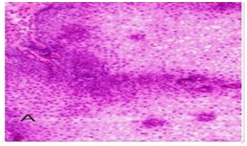Expression of Ki 67 and human papilloma virus 16 with risk factors in cervical pre malignant and malignant lesions
Abstract
Introduction: The present study was conducted to assess immunohistochemical expression of Ki-67 and HPV 16 in premalignant and malignant lesions of cervix. It was also intended to study the risk factors which may be associated with these lesions in Uttarakhand state of India.
Material and Method: The study including premalignant and malignant lesions of cervix diagnosed over period of one year. Immunohistochemical staining on paraffin blocks for all cases and controls were done for HPV 16 and Ki-67. Ki-67 score was quantified depending on the percentage of positive cells and was statistically analyzed in association with HPV expression.
Results: The study included 50 cases of premalignant and malignant cervical lesions and 50 controls. 87.2% of the HPV 16 positive cases were also positive for Ki-67 expression which was statistically significantly higher in comparison to controls. Ki-67 expression was negative in all the controls while 90% of cases showed positivity for Ki-67. The malignant lesions of cervix show a significantly higher grade of Ki-67 expression in comparison to premalignant lesions (p value< 0.001).
Conclusion: Low socioeconomic and education status, smoking (either active or passive), early age of sexual contact and first conception with high parity were associated with increased risk of cervical premalignant and malignant lesions in this region of India. Ki-67 plays an important role in carcinogenesis of cervical cancer in association of HPV16. The increase of immunopositivity of Ki-67 with the severity of lesions suggests its use in stratification of premalignant and malignant lesions of cervix.
Downloads
References
2. Kumar V, Abbas AK, Fausto N, Aster JC. Female genital tract. In: Kumar V, Abbas AK, Fausto N, Aster JC, editors. Robbins &Cotran Pathologic basis of disease. 8th ed. Philadelphia (Pennsylvinia): Elsevier; 2010. p.1018-9.
3. Vasilescu F, Ceauşu M, Tǎnase C, Stǎnculescu R, Vlǎdescu T, Ceauşu Z. P53, p63 and Ki-67 assessment in HPV-induced cervical neoplasia. Romanian Journal of Morphology and Embryology. 2009; 50(3):357–61.[pubmed]
4. Hwang SJ, Shroyer KR. Biomarkers of cervical dysplasia and carcinoma. J Oncol. 2012;2012:507286. doi: 10.1155/2012/507286. Epub 2011 Oct 29.[pubmed]
5. Archana S, Eswari V, Prakash G. Ki-67 Expression in squamous intraepithelial lesions and carcinoma cervix by immuno-histochemistry. International Journal of Scientific Research. 2016; 5(8):204–7. doi: 10.15373/22778179.
6. Yi W, Wang JL, Li XH, et al. [Correlations of high-risk human papillomaviral load to cervical intraepithelial neoplasia grades, expression of Ki-67 and P6ink4a and follow-up]. Ai Zheng. 2008 May;27(5):520-4.
7. Bamanikar S, Baravkar D, Chandanwale S, Dharwadkar A, Paranjape S. Study of cervical cytology and its correlation with clinical and histopathological findings. Clinical Cancer Investigation Journal. 2016; 5(5):403-8.doi: 10.4103/2278-0513.197869
9. Roura E, Castellsagué X, PawlitaM, et al. Smoking as a major risk factor for cervical cancer and pre-cancer: results from the EPIC cohort. Int J Cancer. 2014 Jul 15;135(2):453-66. doi: 10.1002/ijc.28666. Epub 2014 Jan 6.[pubmed]
10. Green J, Berrington de Gonzalez A, et al. Risk factors for adenocarcinoma and squamous cell carcinoma of the cervix in women aged 20-44 years: the UK National Case-Control Study of Cervical Cancer. Br J Cancer. 2003 Dec 1;89(11):2078-86. DOI:10.1038/sj.bjc.6601296.[pubmed]
11. Pandey A, Chandra S, Nautiyal R, Shrivastav V. Expression of p 16 INK4a and human papilloma virus 16 with associated risk factors in cervical premalignant and malignant lesions. South Asian J Cancer. 2018; 7(4): 236-9. doi: 10.4103/sajc.sajc_118_17
12. Zouheir Y, Fechtali T, Elgnaui N. Human papillomavirus Genotyping and p16ink4a expression in cervical lesions: A combined test to avoid cervical cancer progression. Journal of Cancer Prevention. 2016; 21(2):121-5.



 OAI - Open Archives Initiative
OAI - Open Archives Initiative


